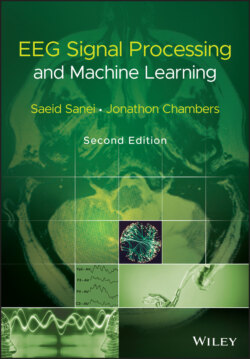Читать книгу EEG Signal Processing and Machine Learning - Saeid Sanei - Страница 15
1.3 Neural Activities
ОглавлениеThe CNS generally consists of nerve cells and glia cells, which are located between neurons. Each nerve cell consists of axons, dendrites, and cell bodies. Nerve cells respond to stimuli and transmit information over long distances. A nerve cell body has a single nucleus and contains most of the nerve cell metabolism especially that related to protein synthesis. The proteins created in the cell body are delivered to other parts of the nerve. An axon is a long cylinder, which transmits an electrical impulse and can be several metres long in vertebrates (giraffe axons go from the head to the tip of spine). In humans the length can be a percentage of a millimetre to more than a metre. An axonal transport system for delivering proteins to the ends of the cell exists and the transport system has ‘molecular motors’ which ride upon tubulin rails.
Dendrites are connected to either the axons or dendrites of other cells and receive impulses from other nerves or relay the signals to other nerves. In the human brain each nerve is connected to approximately 10 000 other nerves, mostly through dendritic connections.
The activities in the CNS are mainly related to the synaptic currents transferred between the junctions (called synapses) of axons and dendrites, or dendrites and dendrites of cells. A potential of 60–70 mV with negative polarity may be recorded under the membrane of the cell body. This potential changes with variations in synaptic activities. If an action potential (AP) travels along the fibre, which ends in an excitatory synapse, an excitatory post‐synaptic potential (EPSP) occurs in the following neuron. If two APs travel along the same fibre over a short distance, there will be a summation of EPSPs producing an AP on the post‐synaptic neuron providing a certain threshold of membrane potential is reached. If the fibre ends in an inhibitory synapse, then hyperpolarization will occur, indicating an inhibitory post‐synaptic potential (IPSP) [20, 21]. Figure 1.3 shows the above activities schematically.
Figure 1.3 The neuron membrane potential changes and current flow during synaptic activation recorded by means of intracellular microelectrodes. APs in the excitatory and inhibitory presynaptic fibre respectively lead to EPSP and IPSP in the post‐synaptic neuron.
Following the generation of an IPSP, there is an overflow of cations from the nerve cell or an inflow of anions into the nerve cell. This flow ultimately causes a change in potential along the nerve cell membrane. Primary transmembranous currents generate secondary ional currents along the cell membranes in the intracellular and extracellular space. The portion of these currents that flow through the extracellular space is directly responsible for the generation of field potentials. These field potentials, usually with less than 100 Hz frequency, are called EEGs when there are no changes in the signal average and called DC potential if there are slow drifts in the average signals, which may mask the actual EEG signals. A combination of EEG and DC potentials is often observed for some abnormalities in the brain such as seizure (induced by pentylenetetrazol), hypercapnia, and asphyxia [22]. We next focus on the nature of APs.
